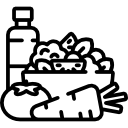The article, delve into the ancient wisdom of Ayurveda and explore its holistic approach to thyroid health. Goiter, commonly known as Gala Ganda, refers to the abnormal enlargement of the thyroid gland. Ayurveda, the traditional Indian system of medicine, provides valuable insights into the causes, symptoms, and treatment of Goiter (Gala Ganda), emphasizing the balance of energies within the body. Join us on this enlightening journey as we uncover the secrets of Ayurveda to manage Goiter (Gala Ganda) and promote overall well-being.
Goiter (Gala Ganda) in Ayurveda:
Understanding the Basics
Goiter (Gala Ganda) is a condition characterized by the abnormal enlargement of the thyroid gland, which is located in the neck. The thyroid gland plays a crucial role in regulating various bodily functions. In Ayurveda, Goiter(Gala Ganda) is believed to occur due to an imbalance of the Vata and Kapha doshas, two fundamental energies that govern the body. When these doshas are disrupted, toxins can accumulate, digestion can become impaired, and metabolic disturbances can arise, ultimately affecting the thyroid gland. Ayurveda takes a personalized concept to healthcare, focusing on restoring the balance of these doshas through various treatments and lifestyle modifications.

The thyroid gland, shaped like a butterfly, is situated at the base of the neck, just below the Adams apple. When the thyroid gland becomes enlarged, it results in a condition known as Goiter. Goiters are typically painless and more commonly found in women over the age of 45-50. While Goiter may or may not be associated with thyroid dysfunction like hypothyroidism or hyperthyroidism, Ayurveda recognizes it as Galaganda. Galaganda is primarily caused by vitiated Kapha dosha, although Vata dosha can also be involved.
In Galaganda, the vitiated Kapha mixes with meda dhatu, leading to an immobile, heavy swelling in the front of the throat. Ayurveda classifies Galaganda into three types: Vataj, Kaphaj, and Medoj.
Vataj Galaganda is characterized by a blackish color, slight pain, dryness, and tastelessness in the throat and mouth. Kaphaj Galaganda, on the other hand, is larger in size, feels cold to the touch, causes minimal pain, and has a sweet taste. Medoj Galaganda presents as an unctuous, whitish swelling with an offensive odor. It may also cause difficulty in speech and an oily sensation in the mouth.
Ayurvedic approach to manage Goiter (Gala Ganda) involves addressing the underlying imbalance of the doshas. Through personalized treatments and lifestyle modifications, Ayurveda aims to restore the balance of Vata and Kapha doshas, thereby promoting the overall health of the thyroid gland. These treatments may include the use of herbal remedies, dietary adjustments, and lifestyle changes.
Symptoms of Goiter(Gala Ganda)
Goiter (Gala Ganda) can manifest with various symptoms, including:
-
Swelling or enlargement of the thyroid gland
-
A visible lump or bulge in the neck
-
Difficulty swallowing or breathing
-
Hoarseness or changes in voice
-
Coughing or wheezing
-
Feeling of something pressing inside the throat
-
Feeling of heaviness in the bod
-
Nausea and vomiting
-
Protruding eyes
-
Feeling sleepy most of the time
-
Raised cholesterol level
-
Changes in the menstrual flow
-
Neck vein distension
-
Rapid heartbeat
-
Diarrhea
If one has experience any of these symptoms, it is crucial to consult a qualified Ayurvedic practitioner for a proper diagnosis and treatment.
Goiter (Gala Ganda) in Ayurveda: Causes and Risk Factors
Ayurveda identifies several factors that can contribute to the development of Goiter(Gala Ganda). These include:
-
Imbalanced diet:
Consuming excessive amounts of cold, heavy, and processed foods can disrupt the natural balance of the doshas and contribute to Goiter(Gala Ganda).
-
Impaired digestion:
Weak digestion can lead to the accumulation of toxins in the body, which may affect the thyroid gland.
-
Lifestyle choices:
Sedentary lifestyle, lack of exercise, and irregular sleep patterns can disturb the doshas and increase the risk of Goiter(Gala Ganda).
-
Environmental factors:
Exposure to environmental toxins, such as pollutants and chemicals, can also influence the development of Goiter(Gala Ganda).
It is important to address these underlying causes to effectively manage and prevent Goiter(Gala Ganda) in Ayurveda.
Difference of Thyroid & Goiter
Thyroid and goiter are two related but distinct terms that are often used in the context of thyroid health. Understanding the difference between the two can help clarify their specific meanings and implications. The thyroid is a small, butterfly-shaped gland located at the base of the neck, just below the Adam’s apple. It plays a crucial role in regulating the body’s metabolism, growth, and development. The thyroid gland produces thyroid hormones, namely triiodothyronine (T3) and thyroxine (T4), which are responsible for controlling various bodily functions.
Goiter, refers to the abnormal enlargement of the thyroid gland. It is a visible swelling or lump that can be felt or seen in the neck area. A goiter can occur due to various reasons, including underlying thyroid conditions, iodine deficiency, inflammation, or certain medications. Goiter refers to the enlargement or swelling of the thyroid gland.
Thyroid disorders can be categorized into different types, including hypothyroidism (underactive thyroid), hyperthyroidism (overactive thyroid), thyroiditis (inflammation of the thyroid gland), and thyroid nodules (abnormal growths within the thyroid). These conditions can cause the thyroid gland to malfunction and result in the development of a goiter.
It is important to note that not all goiters indicate a thyroid disorder. Some goiters may be benign and not cause any significant health issues, while others may be associated with thyroid dysfunction, such as hypothyroidism or hyperthyroidism. Therefore, a thorough medical evaluation and diagnostic tests are necessary to determine the underlying cause of a goiter and its associated thyroid function.
Treatment options for thyroid disorders and goiters may vary depending on the specific condition and its severity. They can range from medication to surgical interventions, and in some cases, lifestyle modifications and natural remedies may also be recommended.

Etiology of Goiter
The most common cause of goiters is a deficiency of iodine in the diet. In areas where the use of iodized salt is not common, goiters are more likely to occur due to the inadequate intake of iodine. In addition to iodine deficiency, there are various other factors that can contribute to the development of goiters. Exposure to radiation, whether from medical treatments or environmental sources, can increase the risk. Pregnancy can also lead to goiter formation, as the hormone human chorionic gonadotropin (HCG) produced during pregnancy can cause the thyroid gland to enlarge slightly. Menopause, disorders of the pituitary gland and hypothalamus, and a family history of autoimmune diseases can also be underlying causes.
Certain medications, such as antiretroviral drugs, cardiac medications, and immunosuppressants, have been associated with goiter development. Cigarette smoking and infections caused by bacteria, viruses, or fungi can also contribute to the formation of goiters. Additionally, certain food items, including soybean, spinach, and peanuts, have been found to increase the risk of developing goiters.
Ayurvedic Treatments for Goiter (Gala Ganda)
Ayurveda offers a holistic approach to treating Goiter (Gala Ganda), focusing on restoring the balance of doshas and promoting overall well-being. Here are some Ayurvedic treatments that can be beneficial:
-
Herbal Remedies
Ayurveda utilizes various herbs with potent medicinal properties to support thyroid health and reduce the swelling of the thyroid gland. Some commonly recommended herbs include:
- Kanchanara (Bauhinia variegata): This herb is known for its anti-inflammatory properties and is often used to reduce the size of the thyroid gland.
- Guggulu (Commiphora mukul): Guggulu is renowned for its detoxifying properties and can help eliminate toxins from the body, promoting thyroid health.
It is important to consult an experienced Ayurvedic practitioner for personalized herbal recommendations based on your specific condition.
-
Dietary Recommendations
Ayurveda places great emphasis on the role of diet in maintaining optimal health. When it comes to Goiter (Gala Ganda), following a balanced and nourishing diet is crucial. Consider the following dietary recommendations:
- Include iodine-rich foods such as seaweed, iodized salt, and seafood in your diet, as iodine deficiency can contribute to Goiter (Gala Ganda).
- Emphasize the consumption of fresh fruits and vegetables to provide essential nutrients and antioxidants to support thyroid function.
- Avoid processed and refined foods, as they can disrupt the doshas and impair digestion.
-
Lifestyle Modifications
In addition to herbal remedies and dietary changes, Ayurveda suggests incorporating lifestyle modifications to support thyroid health. Here are some recommendations:
- Engage in regular physical activity to stimulate metabolism and promote overall well-being.
- Practice yoga and pranayama (breathing exercises) to reduce stress and balance the doshas.
- Ensure an adequate amount of restful sleep to promote hormonal balance and optimal thyroid function.
By implementing these lifestyle modifications, you can enhance the effectiveness of Ayurvedic treatments for Goiter (Gala Ganda).
FAQs
Ayurveda provides holistic approaches to manage Goiter(Gala Ganda) and promote thyroid health. While individual results may vary, Ayurvedic treatments can help reduce the size of the thyroid gland and alleviate symptoms.
In some cases, surgical intervention may be required, especially if the Goiter(Gala Ganda) is causing severe symptoms or compromising the airway. However, Ayurveda aims to address the underlying causes and manage Goiter (Gala Ganda) through natural means whenever possible.
The duration of treatment can vary depending on various factors, including the severity of the condition and the individual's response to Ayurvedic therapies. It is advisable to consult with an Ayurvedic practitioner to get an estimate of the expected treatment duration.
When administered under the guidance of a qualified Ayurvedic practitioner, Ayurvedic treatments for Goiter (Gala Ganda) are generally safe and well-tolerated. However, it is essential to disclose any pre-existing medical conditions or ongoing medications to ensure safe treatment.
Ayurveda focuses on addressing the underlying imbalances that contribute to Goiter(Gala Ganda). By adopting a holistic approach to health and following Ayurvedic principles, can reduce the risk of Goiter (Gala Ganda) recurrence.
Ayurveda recognizes the individuality of each person and tailors treatments accordingly. It is advisable to consult with an Ayurvedic practitioner who can assess your specific condition and provide personalized treatment recommendations.









Nice article, perfect combination of Ayurvedic and modern views. Valuable piece of knowledge for all the Ayurvedic practitioners as well as general public. Keep posting such articles.
Hello, my mother is diagnosed with retrostenal thyroid gland extension and touching trachea (windpipe). Can Ayurvedic treatment help to reduce the size of goiter if it is retrostenal? I’m trying to avoid surgery for her. Thank you